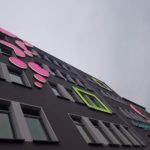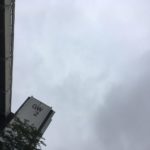
James Lamb and I, both of the Centre for Research in Digital Education at the University of Edinburgh recently completed a mobile learning activity as part of the 3rd Bremen Conference on Multimodality in Germany. We had about 20 participants for this activity, which involved an attempt to activate seminal literature into some sort of disciplinary specific framework for mobile learning. That is the substance of the literature is translated into activity, discussion, or just reflection, all while conducting a walk through the streets of a city.
Although we have done mobile learning activity before (Edinburgh, Amsterdam, London, Helsinki with Pekka Ihanainen, Seoul, and so forth), this framework was different in that we toyed with levels of automation in instruction. The entity delivering the instructions, passages, questions, and so on was myself, but I was doing it from a script and at timed intervals. I was removed from the walk itself and participants were free to take a direction they saw fit. It is, in essence, a distributed model for mobile learning and one that we suspect can scale. We used Telegram as it provided a relatively secure, relatively accessible mobile application that allowed for more or less media types. The Telegram app was used for receiving and sending instructions and other content as we explored the city, as well as offering us a way of reflecting on the complex relationship between researcher and technology, and the implications for our work around multimodality.
All the prompts were preceded by a representative character appearing in the Telegram group. When Virginia Woolf appears on screen, this was to announce the arrival of an idea from the literature, something to inform the walk and work on the cognitive and dispositional elements in the background. When Salvador Dali appears there was a call to action: an activity to be carried out individually or in the group. Meanwhile Sigmund Freud was for discussing a particular question or idea with those around you. If we scale this out a bit more, I fully intend to create a suite of images specifically for mobile learning.
The example below (the first prompt delivered after the walk commenced five minutes prior) was a passage from the literature on multimodality:

Each of the prompts toyed with a theme, or attempted to engage the literature through an activity or discussion. An example activity below attempted to probe into the distinctiveness of the urban space and how we extract spatial identity from the signs and symbols around us. I am sure a multimodality person would have a better explanation than this but my mobile learning background has made me intensely curious as to relational identity and the “generalized elsewhere.”

So this was a good example of where mobile learning and multimodality could intersect in this one activity. James can speak to the multimodal aspects of this, but I was drawing as I often do Adriana de Souza e Silva & Jordan Frith (2010):
Locations, however, are not isolated entities. They are relational, and their meaning derives from their ability to develop connections to other locations. Consequently, locations will be understood differently depending on which other locations are perceived as connected to them…While geographical features play a role in the construction of spatial identity, places do not construct their identity on their own. Their identities are instead constructed by people. People attribute meanings to places. These meanings are created by the elements that exist in a place, such as physical elements (e.g., buildings, public plazas, streets), social elements (e.g., the people who live in them), cultural elements (e.g., historical traditions, folklore, etc.), and the various ways that these categories converge. The interaction of these elements is what gives spaces their identity. As Henri Lefebvre argued, spaces are not merely containers. They are constructed by social relationships, but those social relationships are not limited to the people who live in a specific place; instead, places are also influenced by other people who live elsewhere….mass communication media actually helped people foster greater emotional attachments to places, through what he calls the “generalized elsewhere.” According to Meyrowitz, the generalized elsewhere works as a mirror in which to view and judge our localities. The generalized elsewhere makes us more aware of our local spaces because they acquire relationality. The comparison to other localities adds meaning to places.”
So this activity engaged a bit of this sentiment. The activity also engaged the position of mobile learning that I have been trying to articulate for years. From the introductory preamble we gave on the day to the group:
our position on mobile learning revolves around both cognitive development and disposition. We want to move beyond the normal tropes of anytime, anywhere configuration and into something a bit more cognitive. We believe mobile learning is learning that occurs across multiple contexts, amongst people, and interactive technologies and involves both an evolving cognitive understanding and a dispositional one. The mobility is partly about our capacity for perceiving the world around us.
So a series of passages from the literature, questions for discussion, and activities all while conducting a walk, all really driving at foregrounding this cognitive and dispositional mobility. It lasted about 60 minutes and generated quite a bit of data and feedback which we will process and use to share our next iteration. Some examples below from the activity. These were selected precisely because they allow participants to remain anonymous; all the other images involved images of people and fellow participants. There was some audio and video data as well submitted but for the most part participants relied on text and image, not surprisingly.
This method/emerging framework will need to evolve and be developed in tandem with disciplinary practices, but I suspect it has legs. I believe this a model that allows for distributed teaching practice at scale, potentially allows for intimate peer arrangements of collegiality, and measures of automated and instructional interaction. The automated elements really speak to the scalability as the activity can be run without that automation if so desired. I suspect it allows, or at least leaves room for, rigorous disciplinary practice and the reinvigoration and reinvention of field work as a distributed model. More on that in future posts.
Again, satisfying my development work as well, it speaks to the digital divide as it is highly accessible, even for those instructors without technological confidence, and even for those with less advanced mobile technology. It is basically just MMS which can run on many if not most phones. It is also essentially an intimate chat room within a larger discussion. So theoretically you could have many of these mobile messaging groups running in tandem with greater or lesser degrees of institutional control and synchronisation.
Did everything work? Certainly not. There were moments when we could have provided more clarity in our signalling and communication, moments when the rain and the fatigue dampened (pun intended) enthusiasm. There is a real necessity to move this beyond novelty into something pragmatic, but we are getting there slowly.
- De Souza e Silva, A., & Frith, J. (2013). Re-narrating the city through the presentation of location. The Mobile Story: Narrative Practices with Locative Technologies, London, NY: Routledge.











#mLearning in #Bremen: takeaways from a recent field activity using #MMS organised by @james858499 and I… https://t.co/kGWAXqN9by
RT @mseangallagher: #mLearning in #Bremen: takeaways from a recent field activity using #MMS organised by @james858499 and I https://t.co/h…
#mLearning in Bremen: takeaways from a recent field activity https://t.co/xURshcdqcz https://t.co/Qt3h29g0RO
#mLearning in Bremen: takeaways from a recent field activity with @james858499 https://t.co/7HiMggsBZQ https://t.co/0eilWOFGYo
[…] so. It has been field tested in some configuration many times by the organisers (Edinburgh, Bremen, Seoul, Helsinki, Amsterdam, London, New York, and […]
[…] with a previous mLearning event in Bremen, we used the mobile messaging application Telegram. Just as in Bremen, this choice was largely […]